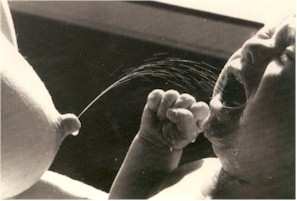 One of the hardest things for new moms to deal with is a cranky, inconsolable baby. There will be times when you have done all the ‘right’ things: feeding, burping, changing her diaper, making sure she’s not too hot or too cold…
One of the hardest things for new moms to deal with is a cranky, inconsolable baby. There will be times when you have done all the ‘right’ things: feeding, burping, changing her diaper, making sure she’s not too hot or too cold…
And she still isn’t happy.
This will happen more than once. It happens more when your baby is an infant, because tiny babies have no way to communicate other than by body language or crying. It happens more in the evenings, when you and your baby are the most tired, and your milk supply is lowest as well.
There is nothing good about a crying baby. Saying that crying is good for your lungs makes about as much sense as saying that bleeding is good for your veins. It’s one of those old wives tales that makes no sense at all.
So what do you do when you’ve tried everything and she’s still fussy? Here are some things to try…but first, Let me make it clear that I can’t guarantee that any of these things will work. Sometimes babies are just fussy no matter what you do, and you have to wait it out without feeling guilty about what a terrible mom you are.
There are two professional terms you may not be familiar with: “Shh…Shh…Shh…Shh” and “Jiggling”.
“Shh…Shh…Shh…Shh” is the comforting sound that every mother in the world makes. I’ll refer to it as “Shushing” for the sake of brevity.
Jiggling is – well – jiggling. Holding the baby close and gently moving her up and down. You know, jiggling. It’s an automatic response when you hold a fussy baby. Motion is very soothing to babies. However, the cradle hold will put her in the nursing position, so if you try to breastfeed her and that’s not what she wants, hold her upright close to you and jiggle instead.
Another important thing is that while none of these techniques work all the time, and some of them don’t work at all at any given time, you often have better luck with them if you combine them. For example, baby wearing outside while shushing, or rocking while listening to music, or swaddling and swinging, often work better in conjunction with other methods than they do alone. When your baby is crying, you’ll do pretty much anything make her stop.
- The first thing to try is always nursing. Breastfeeding is SO much more than a milk delivery system. It works when your baby is sleepy, stressed, frightened, sick, lonely, in pain, or bored– not just when she’s hungry. So when she fusses, offer the breast, even if she just ate. You can’t make her nurse if she really doesn’t want to, so you haven’t lost anything by trying. Don’t be afraid to use your breast as a pacifier, no matter what your well meaning friends and family tell you.
- When in doubt, whip it out. You’ll be amazed at how often it works. Sometimes it’s almost magical. When your fussy baby does latch on and settles down you get a rush of oxytocin, the ‘mothering’ hormone that helps you relax as your milk lets down. Suddenly life is good again.
- Let her use you for a pacifier and nurse for comfort. If nursing doesn’t work, you or dad can let her suck your clean finger, pad side up. If that doesn’t work, It’s okay to try a pacifier. Sometimes babies just want to suck themselves to sleep, but they aren’t hungry so they won’t take the breast. It’s almost like they get angry when they suck and milk comes out. Try to avoid using a dummy during the first few weeks of nursing to avoid nipple confusion, but it isn’t the kiss of death for breastfeeding if you do. Many babies have no problem switching back and forth. A pacifier can be a life saver in certain situations, like when you’re driving down the highway with baby in the back and she’s screaming her head off and you can’t stop the car to nurse her.
- Learn to read your babies cues. Even very young babies can communicate if you’re tuned in to them. Crying is a late feeding cue, so learn to recognize his early signals befores he gets upset enough to cry. Here are photos of a newborn’s feeding cues.
- Be prepared for cluster feedings. When your baby is going through a period of especially rapid growth, she may want to nurse ‘all the time’, or at least it seems like it. You feed her, and half an, hour later she fusses and wants to eat again. This frequent breast stimulation is what sends your breasts the signals to make more milk and the cluster feedings usually only last a few days as the supply increases to meet the demand.
- Ssssh…Shshh…Sshh. Say that over and over quietly in your baby’s ear. I’m pretty sure moms have been making that same shooshing sound since the beginning of time. It’s the same in any language. Shushing works best if combined with holding and jiggling.
- Try swaddling. Swaddling your baby means wrapping him closely in a light blanket. Some babies love it, some babies absolutely hate it. Swaddling often works well with newborns, because it’s soothing for newborns to feel safe in their cocoon, but older babies generally hate to have their arms confined. It can be a useful technique to learn for a fussy, agitated baby who seems to keep himself awake by waving his arms and kicking his legs. You can also buy special swaddler blankets if you want to make it even easier, and you can always swaddle him in a way that leaves his hands free if he wants to put them in his mouth.
- Baby swings. I think a swing is an important piece of baby equipment. Borrow one or buy one used because they take up a lot of room, and your baby won’t use it for very long. Some babies don’t like it the first couple of times you try it, but almost all of them will use it some when they’re newborns. Once they’re a few months old and begin to be more social, they aren’t usually willing to stay in it for long. Swings are especially helpful if you have older kids. I wouldn’t have been able to eat a meal without nursing a baby if I hadn’t had a swing right there in the kitchen next to the table. Babies have a sixth sense when you sit down to eat, and sometimes the swing can buy you a few minutes to grab a bite to eat. It goes without saying (but I’ll say it anyway) that babies should never be left unattended in a baby swing, even for a second.
- Rocking. Every new mom needs a rocking chair if at all possible. Trust me, it’s more important than a Diaper Genie or a Hooter Hider.
- Dim the lights and minimize distractions. Light a candle. Play some soft music. These things are for you as much as they are for the baby
- Make noise. If dimming the lights and keeping the room quiet doesn’t work, try noise. Sing. Even if you can’t sing worth a lick, your baby doesn’t care. If you don’t want to sing, trying humming. Play music. Some babies calm down more when they hear quiet classical music, some do better with ZZ Top. Find what works for you. Here’s an idea for a baby gift: Make a mixed tape of calming music, and put the baby’s pic on the CD case. It makes a great gift for a new mom, who will think of you when she’s sitting up in the middle of the night rocking a fussy baby
- Turn on a fan or a white noise machine. Anything with a constant sound of rushing (much like shushing – are you sensing a pattern here?) has a soothing effect. I’ve slept with a noise machine for years. You can set it to make all kinds of different sounds – my favorite is the ocean, but you can also set it for rainfall, crickets chirping, and heartbeat. It wasn’t expensive. I shopped around and got one for $50.00. One of the best investments I ever made. I don’t leave home without it. Works well for grown ups as well as babies.
- Wear your baby. Learn to use a baby sling. Mothers have been wearing their babies since the beginning of time, because it works. Babies were in the womb for nine months feeling warm and safe and connected to mom, and you can duplicate that feeling by holding your baby close. If you get really good at it, you can learn to do all kinds of stuff while you’re baby wearing because it leaves your hands free.
- Go outside if you can. The stroller is optional, but sometimes just stepping outside for a breath of fresh air can help you and the baby regroup. Wearing your baby outside works even better
- Put the baby in an infant seat and set it on top of the dryer. Turn the dryer on, and stand there and pat him and shoosh him and watch him every second. If you can afford it, get one of those baby seats that vibrate, but don’t expect it to work all the time.
- Go for a ride in the car. I know people who’ve driven around the block for hours with a fussy baby. All moms learn very quickly that babies tend to fall asleep in the car, often when you don’t want them too. They take a short nap and are then good to go for hours. However, if your baby is fussy enough, you’ll do just about anything to make it better.
- Take a bath with your baby. Younger babies usually hate baths, so that’s not the best calming technique. Being in the tub with mom is a whole different thing. It combines the soothing back-in-the womb effect with the skin to skin contact, and many babies will nurse better in the warm water than they will anywhere else. Shooshing can be used in conjuction with the bath sharing technique.
- Massage. Make sure the room is warm, and don’t try it when he’s screaming his head off. Put some oil in your hands and rub them together to warm then up, then gentle rub him all over, especially his tummy. Massage in a clockwise direction, sort of like rubbing a cat’s fur in one direction. Gently bend his knees, toward his belly in a pedaling motion, which may help him pass gas. You don’t have to be a professional or take classes to do this. Your baby will let you know what feels best.
- Colic is a whole different thing. About 1 out of 5 babies develop colic, which means they cry for three or more hours a day, for three weeks or more. It usually peaks at around 6 weeks, and clears up on its own by three months. Babies have had colic for hundreds of thousands of years, and we still don’t know exactly what causes it. Colicky babies cry an insane amount of time. They scream, turn red, pull their legs up, have stomach spasms, and their cry even sounds different – it’s higher pitched and sounds like they are in horrible pain. There is no cure for colic, but thank God it doesn’t usually last more than three months (which seems more like three years).
(Mylicon/Gripe water) contain simethicone, and won’t do any harm, but chances are they won’t really help, either. It’s more of a placebo effect, and makes you feel like you’re doing something to help. Although no one is exactly sure what causes colic, the most likely culprit is the protein in dairy products, which can come with formula feeding, or with the protein appearing in the mother’s milk and being passed to the baby. If you’re nursing your baby, he is much less likely to develop colic, but it does happens to breastfed babies, too. My first was a 35 week preemie, and he was so fussy for the first few months that it’s a wonder I went on to have five more babies, but I did – and not one of them was colicky. - The colic hold will sometimes help, because it puts gentle pressure on the abdomen. You can place a heating pad set on low, covered by a towel or blanket, on your arm or lap, and that may help as well. Dr. Sears has a list of colic holds that are all a variation of the same theme: putting gentle pressure on the baby’s belly. In this link, you can find out about the football hold: Place your baby stomach-down along your forearm, with his head near the crook of your elbow and his legs straddling your hand. Press your forearm into baby’s tense abdomen. Or, try reversing this position so that his cheek lies in the palm of your hand, his abdomen along your forearm, and his crotch snuggled into the crook of your elbow, as well as the colic curls and tummy rolls. These techniques are especially good for dads to use, because they may feel especially helpless when it comes to baby’s crying because only moms can breastfeed, which is the thing that works the best (most of the time) for fussy babies. http://www.askdrsears.com/topics/health-concerns/fussy-baby/coping-with-colic/10-tips-comforting-colic
- If nursing doesn’t help, it may be something in your diet, although this is unusual. If the baby is fussy because of something in your breast milk, it is most likely protein from cow’s milk that passes into your milk. Eliminating dairy or other allergenic foods like peanuts, wheat, eggs, or soy may help, but it’s hard to tell. By the time you try eliminating all these foods and giving them time to get out of your milk, your baby is likely to have reached the three month mark and the colic is going away by itself. The really awful thing about colic is that no matter what you do (including nursing) won’t make it go away. Nursing is the best way to comfort your colicky baby, but it won’t cure him. Mothers with colicky babies have a higher incidence of postpartum depression, which makes sense. Trying to comfort a crying baby who is in obvious distress is incredibly stressful.
- Take care of mama. Make sure you eat enough to have the energy it takes to deal with this little person who will sometimes cry no matter what you do. Remember to eat something, even if it’s a protein bar. It may be hard for those of you who haven’t had a baby to imagine forgetting to eat, but believe me, it happens.
- If you feel close to losing it, take a break. Put your baby on her back in her crib and walk away for a bit, taking deep breaths until you regroup. It won’t scar your baby for life is she fusses for a few minutes. If your partner is there and you just nursed ands he won’t take the breast again, let daddy jiggle and shoosh and sometimes the baby will settle down and fall asleep on his chest. If the baby is older than a few weeks, this might be a good time to let daddy give him a bottle of expressed milk.
In the first few months of parenting, you are in the survival mode, especially if you have a colicky baby. Do whatever it takes to calm your fussy baby down. Swings, massage, a warm bath, a pacifier, or a glass of wine for you. Don’t beat yourself up if your baby is fussy and nursing doesn’t calm him down. Babies work in mysterious ways, and this too shall pass.
Anne Smith, IBCLC
Breastfeeding Basics
 Breastfeeding Basics
Breastfeeding Basics




